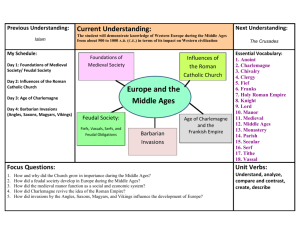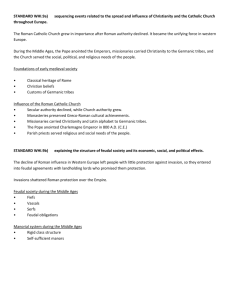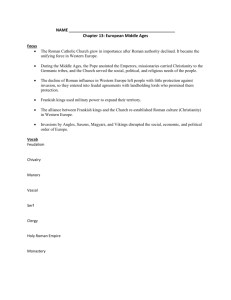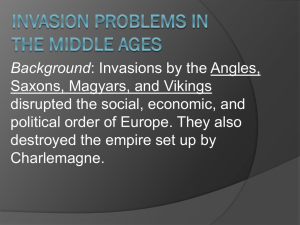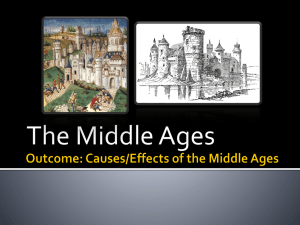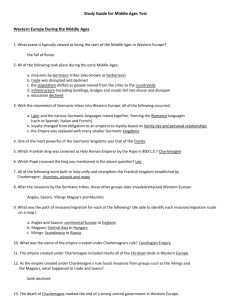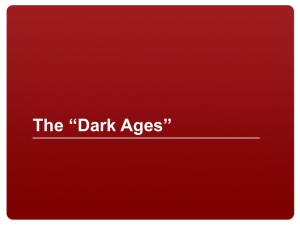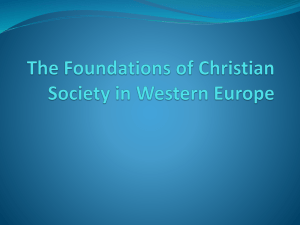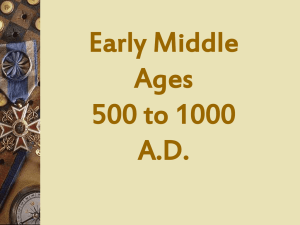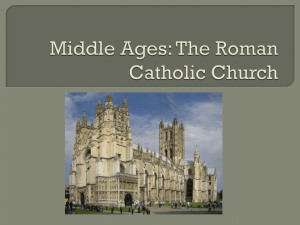Europe in Middle Ages
advertisement
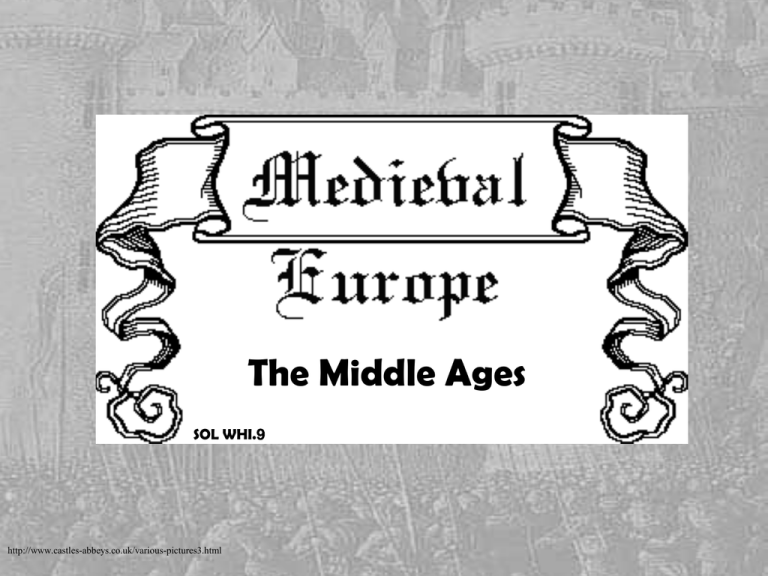
The Middle Ages SOL WHI.9 http://www.castles-abbeys.co.uk/various-pictures3.html 500 – 1500 A.D. Period of history known as the MIDDLE AGES. Europe in Middle Ages 476 A.D. Western Roman Empire collapses due to Germanic invasions. Roman Empire •Large territory unified under one government •Led by an emperor •Large cities, money economy, literate society, etc. •Small Germanic kingdoms; boundaries constantly changed •Money scarce; trade disrupted by invasions; cities faded; illiterate society •People entered into agreements with land owning lords who provided them with protection in exchange for work. Foundations of medieval society • Classical heritage of Rome • Christian beliefs • Customs of Germanic tribes Feudalism begins Invasions shattered Roman protection over the Empire. The decline of Roman influence in Western Europe left people with little protection against invasion, so they entered into feudal agreements with land-holding lords who promised them protection. Feudal society during the Middle Ages • Fief – land worked by the peasants • Vassals – “landlords”; swore allegiance to the king; could serve as a knight • Serfs – peasants that worked the land • Feudal obligations Manorial system during the Middle Ages • Rigid class structure • Self-sufficient manors Feudalism Fiefs – land grants Provide knights in times of war Military protection Fiefs – land grants service protection Based on mutual obligation Life on the Manor Daily Life on the Manor Influence of the Roman Catholic Church during the Middle Ages • The Roman Catholic Church grew in importance after Roman authority declined. It became the unifying force in western Europe. • The Pope anointed the Holy Roman Emperors. • Missionaries carried Christianity to Germanic tribes. • The Church served the social, political, and religious needs of the people. St. Peter’s Basilica Vatican City, Italy Built 326 A. D. Influence of the Church • Roman authority declined, while Church authority grew • Monasteries preserved Greco-Roman cultural achievements • Missionaries carried Christianity and Latin alphabet to Germanic tribes • Pope anointed Charlemagne as Holy Roman Emperor in 800 A. D. • Parish priests served religious and social needs of the people Age of Charlemagne Frankish kings used military power to expand their territory. • Franks emerged as a force in Western Europe • Charles I, Charles the Great = Charlemagne • Pope crowned the Emperor of the Holy Roman Empire. The alliance between Frankish kings and the church reestablished Roman culture in Western Europe. • Power of the Church was established in political life • Roman culture was revived Charlemagne • Born grandson of Charles Martel, son of Pepin the Short • Ruled from 771 - 814 A.D. • Known as Charles I • Spread Christianity while reuniting western Europe • Crowned by Pope Leo III Christmas Day 800 A. D. • Died at age 70 Charlemagne’s Empire Invasions by the Angles, Saxons, Magyars, & Vikings Vikings Magyars Invasions by the Angles, Saxons, Magyars, & Vikings Invasions by Angles, Saxons, Magyars, and Vikings disrupted the social, economic, and political order of Europe. Areas of Settlement • Angles and Saxons from continental Europe to England • Magyars from Central Asia to Hungary • Vikings from Scandinavia to Russia Influence of the Angles, Saxons, Magyars, & Vikings • Manors with castles provided protection from invaders • Invasions disrupted trade, towns declined, and the feudal system was strengthened
